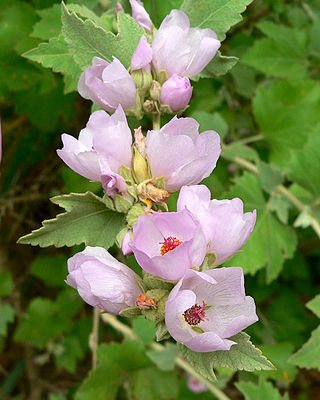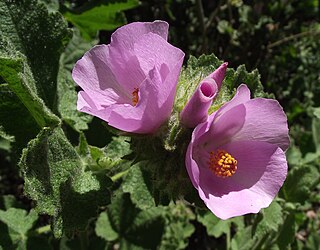
Trichomes are fine outgrowths or appendages on plants, algae, lichens, and certain protists. They are of diverse structure and function. Examples are hairs, glandular hairs, scales, and papillae. A covering of any kind of hair on a plant is an indumentum, and the surface bearing them is said to be pubescent.

Malacothamnus (bushmallow) is a genus of shrubs found throughout much of mainland California and on three of the Channel Islands. Outside of California, Malacothamnus is known from the northern half of Baja California and from a few disjunct locations in Arizona. Plants of this genus are most commonly found in early-successional, post-burn plant communities. Malacothamnus are currently thought to be most closely related to the Iliamnas of the US interior and the Phymosias of Mexico, Central America, and the Caribbean.

Malacothamnus davidsonii is a species of flowering plant in the mallow family known by the common names Tujunga bushmallow and Davidson's bushmallow. It is endemic to Los Angeles County, California, where it primary occurs in and near Big Tujunga Canyon, Little Tujunga Canyon, and Tujunga Wash. The common name Tujunga bushmallow alludes to its geographic distribution. Plants of what has historically been considered Malacothamnus davidsonii from Monterey and San Luis Obispo counties in California were described as the new species Malacothamnus discombobulatus in 2023 based on phylogenetic, morphological, and geographic evidence.
Malacothamnus densiflorus is a species of flowering plant in the mallow family, which has two varieties. It is endemic to the Peninsular Ranges of southwestern California and northwestern Baja California.
Malacothamnus fremontii is a species of flowering plant in the mallow family, which has two varieties, one of which is sometimes recognized as the species Malacothamnus helleri. Malacothamnus fremontii is known by the common names unfurled bushmallow and Frémont's bushmallow. Unfurled bushmallow is the suggested common name for people who do not wish to honor Fremont, who led multiple massacres against Indigenous peoples. Malacothamnus fremontii is endemic to northern California in and west of the Sierra Nevada.
Malacothamnus jonesii is a species of flowering plant in the mallow family which has three varieties, two of which are sometimes recognized at the species rank as Malacothamnus gracilis and Malacothamnus niveus. Malacothamnus jonesii is endemic to San Luis Obispo County, California and just over its northern and southern borders in Monterey and Santa Barbara counties.
Malacothamnus palmeri is a species of flowering plant in the mallow family known by the common names Cambria bushmallow and Palmer's bushmallow. It is endemic to San Luis Obispo County, California, where it is known from the Santa Lucia Mountains.
Drosera peruensis is a carnivorous plant of the genus Drosera, commonly known as the Peruvian sundew. This Drosera species was first identified in Peru in 2002 by Tânia Regina dos Santos Silva and Mireya D. Correa following work to update the genus Drosera for the reference text, Flora Neotropica..
Trompettia cardenasiana is a species of nightshade that is a spiny shrub bearing very small leaves, 0.35–0.5 cm (0.1–0.2 in) by 0.1–0.12 cm (0.04–0.05 in), a yellow trumpet-shaped campanulate flower, measuring about 3 cm (1.2 in) long and globose fruit. The growth habit is somewhat reminiscent of certain Lycium species. It is endemic to Bolivia, growing in dry, Andean valleys at elevations of 2,000–2,500 m (6,600–8,200 ft) and 3,000–3,500 m (9,800–11,500 ft) and has been collected near the town of Cotagaita in Potosí Department.

Malacothamnus lucianus is a species of flowering plant in the mallow family known by the common names Santa Lucia bushmallow and Arroyo Seco bushmallow and by the cultivar name Hanging Valley bushmallow. It is endemic to Monterey County, California, United States, where it is known from the Santa Lucia Mountains.
Malacothamnus mendocinensis is a species of flowering plant in the mallow family known by the common name Mendocino bushmallow. It is endemic to Mendocino County, California, where it is known from only two populations. It was presumed extinct until rediscovered in 2016 and now has a California Rare Plant Rank of 1B.1. In some treatments, Malacothamnus mendocinensis has been included within Malacothamnus fasciculatus or Malacothamnus hallii. Phylogenetic and morphological evidence, however, indicate that it is not closely related to these species and should be recognized as a separate species.
Malacothamnus arcuatus is a species of flowering plant in the mallow family, which has two varieties, one of which is sometimes recognized as the species Malacothamnus hallii.
Malacothamnus parishii is a species of flowering plant in the mallow family known by the common name Parish's bushmallow. It is endemic to San Bernardino County, California, where it is confirmed from only a single collection from 1895. It has a California Rare Plant Rank of 1A. Malacothamnus parishii is currently treated as an extreme form of Malacothamnus fasciculatus var. laxiflorus. Phylogenetic analyses are needed to confirm whether it should be treated as a separate species or not.
Malacothamnus orbiculatus is a species of flowering plant in the mallow family known by the common names Tehachapi bushmallow and round-leaved bushmallow. It occurs in California, where it is common after burns on the desert-facing slopes of mountains, and Arizona, where it is currently only known from a few locations. Malacothamnus orbiculatus is occasionally treated within Malacothamnus fremontii but morphological, phylogenetic, and geographic evidence shows them to be distinct species, though there is a small zone of intergradation where their geographic ranges meet.
Malacothamnus astrotentaculatus is a species of flowering plant in the mallow family known by the common name starry-tentacled bushmallow. It is named after the somewhat tentacle-like outgrowths on the calyx that are covered in stellate trichomes. It is endemic to Shasta and Tehama counties in California.
Malacothamnus eastwoodiae is a species of flowering plant in the mallow family known by the common name Alice's lovely bushmallow. It is named after the botanist Alice Eastwood. It is endemic to Santa Barbara County, California and currently only known from Vandenberg Space Force Base.
Malacothamnus discombobulatus is a species of flowering plant in the mallow family known by the common name discombobulating bushmallow. It is morphologically similar to Malacothamnus davidsonii and was treated within M. davidsonii in the past. Malacothamnus discombobulatus is named after the confusion sown from its morphological similarity to M. davidsonii. It is endemic to Monterey and San Luis Obispo counties in California.

Malacothamnus nuttallii is a species of flowering plant in the mallow family known by the common name Ojai bushmallow. It is named after the botanist Thomas Nuttall. It is endemic to Santa Barbara, San Luis Obispo, and Ventura counties in California. It is sometimes treated as a variety of Malacothamnus fasciculatus but morphological, phylogenetic, and phenological evidence show it to be distinct. Malacothamnus nuttallii is widely planted and is in cultivation under the name Malacothamnus fasciculatus ‘Casitas’.
Malacothamnus foliosus is a species of flowering plant in the mallow family known by the common names Ensenada bushmallow and monarch bushmallow. It is endemic to Baja California, Mexico and has been introduced into Los Angeles County, California. Morphological and geographic evidence indicates that M. foliosus could possibly be treated as multiple taxa, but phylogenetic analyses are inconclusive and more research is needed.

Sisyrinchium ostenianum is a species of flowering plant in the family Iridaceae. It is distributed in northern Argentina, Uruguay and southern Brazil, where it grows in grasslands with sandy soils or on rocky outcrops, and sometimes on roadsides.





